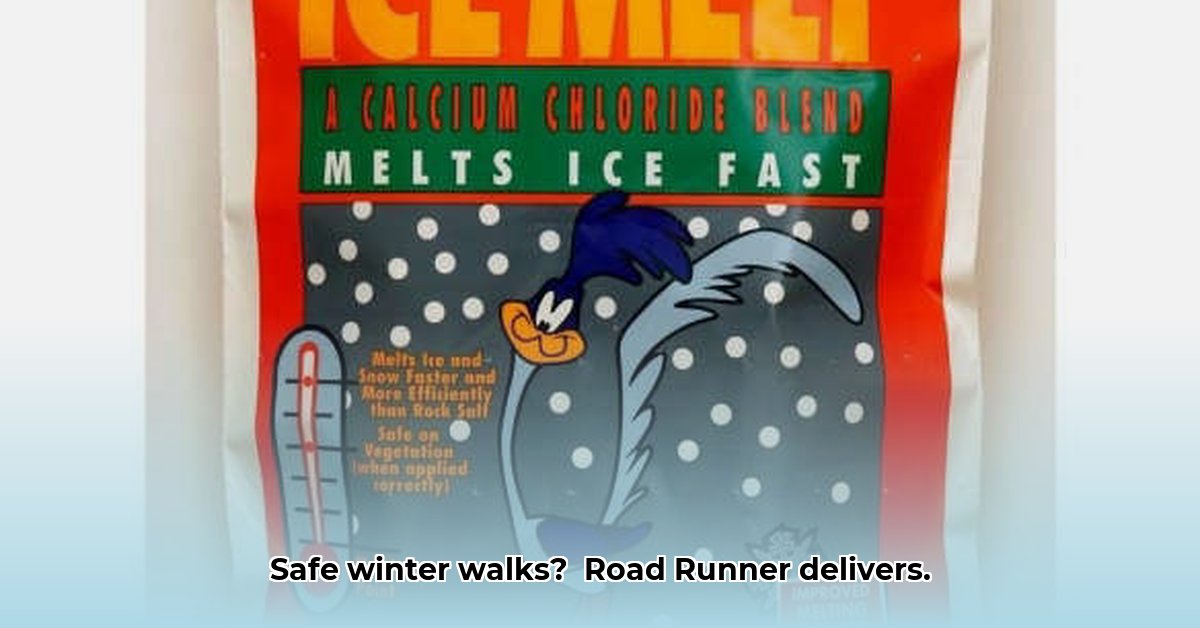Winter’s icy grip poses a significant safety hazard. Slipping on ice can lead to serious falls and injuries. This comprehensive guide dives deep into Road Runner ice melt, providing you with the information you need to determine if it’s the right solution for your driveway, sidewalk, or business property. We’ll analyze its effectiveness in freezing temperatures, discuss its safety for pets and plants, and compare it to competing products. We’ll also evaluate its cost-effectiveness and long-term value, empowering you to make an informed decision and ensure safe walkways throughout the winter season.
Road Runner Ice Melt: Ensuring Safer Winter Walks
Selecting the optimal ice melt for your specific needs requires careful evaluation and consideration. The goal is to mitigate the risks associated with icy conditions and create a safe environment for yourself, your family, your pets, and your customers.
Understanding Your Needs: Homeowner vs. Business Use
The scale of your ice melt requirements will significantly influence your purchasing decisions. Are you treating a small residential driveway, or a large commercial parking lot? Road Runner ice melt is available in a range of package sizes, catering to diverse needs. Homeowners might find smaller bags sufficient, while businesses will likely benefit from bulk purchases to optimize cost and minimize restocking frequency. This parallels grocery shopping – a small household consumes fewer resources compared to a larger family.
Decoding the Ingredients: What’s Inside Road Runner Ice Melt?
Most ice melts rely on chloride compounds to lower the freezing point of water, preventing ice formation in freezing weather. Understanding the specific compounds used in Road Runner ice melt is crucial for evaluating its performance and potential environmental impact.
While the precise formulation may not be explicitly detailed on the packaging, Road Runner ice melt, like many others, typically incorporates a blend of chloride-based compounds, such as magnesium chloride, calcium chloride, and sodium chloride. These compounds work by disrupting the hydrogen bonding in water, thereby lowering its freezing point. This phenomenon is known as freezing point depression.
However, it’s important to recognize that even the most potent ice melts have limitations in extremely cold conditions. If temperatures plummet to -20°F or below, the effectiveness of chloride-based ice melts can be significantly reduced. Therefore, understanding your local climate and typical winter temperatures is essential when selecting the appropriate ice melt product.
Melting Speed vs. Long-Term Effectiveness: What Matters Most?
Ice melts exhibit varying melting speeds and performance characteristics at different temperatures. While “premium” ice melts often boast rapid melting action, it’s crucial to consider whether speed equates to overall effectiveness and value.
A faster melting rate doesn’t necessarily translate to superior long-term performance. In some cases, a slower-acting ice melt that provides sustained melting action over a longer period may be more effective, especially during prolonged freezing weather or heavy snowfall. Road Runner’s performance will depend on specific environmental conditions, including temperature, snow/ice accumulation, and sunlight exposure. The ideal deicing agent depends on the specific situation.
Environmental Considerations: Is Road Runner Eco-Friendly?
Environmental consciousness is increasingly important, and rightly so. While chlorides are effective deicers, they can pose risks to plants, soil, and waterways. Chlorides can elevate the salt content of the soil, potentially harming vegetation and impacting water quality.
If you’re concerned about the environmental impact of ice melt, it’s prudent to explore eco-friendlier alternatives. Consider the potential effects on your lawn, nearby streams, and the broader ecosystem when selecting Road Runner or any other ice melt product.
Pet and Plant Safety: Minimizing Risks
The presence of chlorides and other chemicals in ice melt raises concerns about potential harm to pets and plants. Many ice melt products contain ingredients that can be harmful if ingested or come into contact with sensitive paws or roots.
Road Runner, like most chloride-based ice melts, should be used with caution around pets. Keep it out of reach of animals and supervise them closely in treated areas. For areas near sensitive plants, consider using an alternative, more environmentally friendly deicer. Some ice melt products are specifically formulated to be safer for pets and plants, utilizing ingredients like urea or magnesium chloride in lower concentrations.
Cost Analysis: Finding the Right Balance
The price of ice melt fluctuates significantly based on brand, composition, and quantity. Evaluating the true cost requires considering the melting power per unit, the application rate, and the longevity of the product.
Bulk purchases often provide better value for large-scale applications, such as commercial properties. However, homeowners should carefully assess their actual needs and avoid overbuying. Determining whether a more expensive “premium” ice melt justifies its higher cost compared to a more economical option depends on individual priorities, budget constraints, and performance expectations.
Road Runner vs. The Competition: A Comparative Overview
To aid your decision-making process, here’s a comparative overview of Road Runner ice melt against potential competitors. Please note that this is a general comparison based on commonly available information. Actual performance and user experiences may vary.
| Feature | Road Runner Ice Melt | Competitor A (Calcium Chloride) | Competitor B (Magnesium Chloride) | Competitor C (Pet-Safe Blend) |
|---|---|---|---|---|
| Price per Unit | Moderate | High | Moderate | High |
| Melting Speed | Average | Fast | Moderate | Slow |
| Effective Temp. (-10°F) | Fair | Excellent | Good | Fair |
| Pet Safety | Moderate | Poor | Moderate | Excellent |
| Environmental Impact | Moderate | High | Moderate | Low |
| Residual Effect (Longevity) | Average | Short | Long | Average |
(Note: Specific competitor data is based on general market observations and may not reflect every product within a specific category. Always consult product labels and safety data sheets for detailed information.)
Best Practices: Safe and Effective Application
Proper application maximizes the effectiveness of ice melt while minimizing environmental impact and potential risks.
- Pre-Treatment: Applying ice melt before a snowfall can prevent ice from bonding to surfaces, making removal easier.
- Clear Existing Snow/Ice: Remove as much snow and ice as possible before applying ice melt. This allows the product to directly target remaining ice.
- Apply Sparingly: Overuse is wasteful and can harm the environment. Follow the manufacturer’s recommended application rates.
- Even Distribution: Use a spreader to ensure uniform coverage. This prevents concentrated areas of ice melt.
- Target Shaded Areas: Pay particular attention to shaded areas and areas with poor drainage. These areas are more prone to ice formation.
- Store Properly: Keep Road Runner ice melt in a dry, secure location, out of reach of children and pets.
- Protective Gear: Wear gloves and eye protection when handling ice melt.
Responsible use is paramount. By understanding the properties of Road Runner ice melt, comparing it against alternatives, and adhering to best practices, you can make an informed choice that prioritizes safety, cost-effectiveness, and environmental responsibility.
Selecting the Best Pet-Safe Ice Melt for Cold Climates
Protecting your furry companions during winter walks is a top priority. Traditional ice melts can pose significant hazards to pets. Choosing the right pet-safe ice melt is crucial for ensuring their safety and well-being.
Key Considerations:
- Traditional ice melts (sodium chloride, calcium chloride) can irritate paws and cause internal problems if ingested.
- Urea and magnesium chloride are often marketed as safer alternatives, but ingestion risks remain.
- Always meticulously check ingredient lists. The term “pet-safe” can be misleading.
- Consider the environmental impact and cost-effectiveness of different options.
- Closely supervise pets in treated areas.
Walking your dog in winter shouldn’t be a risky endeavor. Icy sidewalks present a significant hazard to you and your canine companion. How to choose the best pet-safe ice melt for extreme cold is a question every pet owner should consider.
Understanding the Risks of Traditional Ice Melts
Many ice melts claim to be pet-safe, but it’s essential to recognize that some products are significantly safer than others. No ice melt is entirely risk-free if ingested. Traditional ice melts, such as rock salt (sodium chloride) and calcium chloride, are particularly problematic. They can cause painful paw irritation, dehydration, and serious gastrointestinal issues if swallowed.
Exploring Safer Alternatives
Urea and magnesium chloride-based products are generally considered more pet-friendly alternatives. However, it’s vital to remember that even these products can be harmful if consumed in large quantities. Responsible use and moderation are key.
A Step-by-Step Guide to Choosing Pet-Safe Ice Melt
-
Scrutinize the Ingredient List: Carefully examine the product label. Prioritize products with urea or magnesium chloride as primary ingredients. Avoid products containing sodium chloride (rock salt) or calcium chloride.
-
Consider Temperature Performance: Some ice melts perform better in extremely cold conditions than others. Verify the product’s specifications to ensure effectiveness at temperatures below freezing.
-
Assess Environmental Impact: Some ice melts are more environmentally friendly than others. Think about the impact on your lawn, plants, and local waterways. Look for products with reduced chloride content.
- Gray Kitchen Backsplash Tile: Ideas for a Stylish Upgrade - December 14, 2025
- Backsplash For Gray Cabinets: Choosing the Right Backsplash Style - December 13, 2025
- Gray And White Backsplash: Ideas For Timeless Style - December 12, 2025









